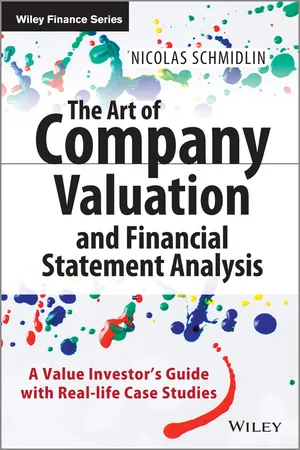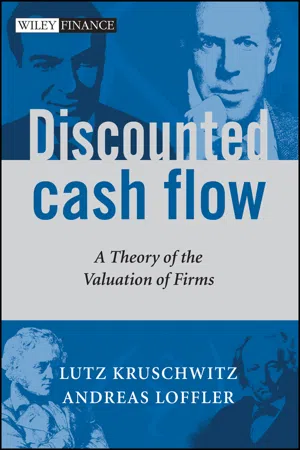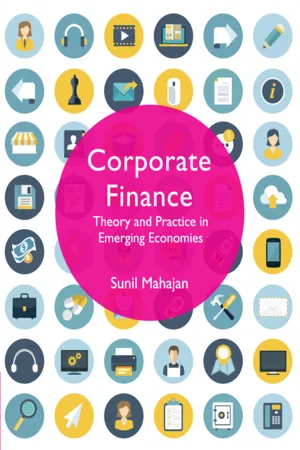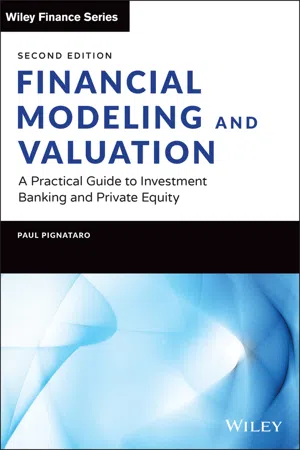Business
DCF Valuation
DCF valuation, or discounted cash flow valuation, is a method used to estimate the value of an investment based on its expected future cash flows. It involves discounting these cash flows back to their present value using a discount rate, which reflects the investment's risk. DCF valuation is widely used in finance and investment analysis to determine the intrinsic value of a business or asset.
Written by Perlego with AI-assistance
Related key terms
1 of 5
11 Key excerpts on "DCF Valuation"
- No longer available |Learn more
The Art of Company Valuation and Financial Statement Analysis
A Value Investor's Guide with Real-life Case Studies
- Nicolas Schmidlin(Author)
- 2014(Publication Date)
- Wiley(Publisher)
The value of companies can also be determined in different ways and is not given as one and the same figure for every investor. An aggressive private equity investor with an intention to liquidate the firm, for example, regards the book value, or more precisely the liquidation value, of a business as the true value. In contrast, a family business owner of the third generation will decline almost any purchase price offer, unless the buyer adopts the family philosophy. A business with M&A intentions, meanwhile, might pay a clear premium on the current market value of a target company, as long as the merger promises synergy effects or opens up new markets.As long as we participate in the stock exchange without any real say, however, just one figure counts: the future discounted cash flows. At the end of the 1930s, the American economist John Burr Williams coined the term of the intrinsic value of a business, based on its discounted cash flows. This approach is nowadays known as the discounted cash flow model (DCF model).The only objective company value is determined by the future free cash flow of a business, i.e. the amount that the owner could withdraw from the excess cash flow year after year without having a negative impact on the company. In order to take into account the prevailing level of interest rates and business risks, the expected future cash flows have to be discounted at a risk-adjusted interest rate. This results in the present value of the cash flows, which corresponds in sum to the intrinsic company value. In simple terms, the value of a business is measured by its expected cash flows, from which withdrawals could be made, across the entire lifetime of the enterprise.Whilst revenues, operating earnings and net profit are theoretical concepts, company valuation based on income or cash flow approaches focuses its analysis on the cash that has actually been received, i.e. the cash flow. The cash flow-based assessment is illustrated below in an example.Example 8.1 – Oil well
After an initial investment of $1,000, an oil well in the Gulf of Mexico delivers oil worth $1,000 over the following three years. The income is secured because fixed prices were agreed with the customer and there are no further costs. The current risk-free interest rate is 5% p.a., and the initial investment of $1,000 could therefore be invested alternatively without risk. Thanks to tectonic peculiarities the oil well is considered to be particularly stable and the steady oil flow for the next three years is guaranteed and risk-free. After the three years the oil well is closed down without further cost. The cash flows are as shown in Table 8.1 - eBook - PDF
Real Estate Appraisal
From Value to Worth
- Sarah Sayce, Judy Smith, Richard Cooper, Piers Venmore-Rowland(Authors)
- 2009(Publication Date)
- Wiley-Blackwell(Publisher)
Structuring investment appraisals to determine investment worth 139 A number of countries, such as the US and Australia, use DCF widely to the point that it has become a recognised and approved explicit valuation tool. In fact the Australian Institute of Valuers and Land Economists goes further and has drawn up industry standards for DCF appraisals. These cover a comprehensive range of items including layout styles, required information, such as whether the cash flows are conventional or non-conventional, mathematical conventions, software used and its underlying assump-tions, and an explanation and glossary of terms. 7.5 Introduction to property discounted cash flows The creation of a DCF appraisal model for a property with a single tenant, and let on a long FRI lease with upward only rent reviews, is relatively straightforward. However, increas-ing complexity is brought on board with multi-let properties and where there is one or more of the following: non-recoverable outgoings, indexation of rents, short leases and void potential, gearing, tax issues, and intricate structures. In essence, the worth calculation requires the appraiser or property analyst, in con-sultation with the client (the owner or potential bidder), to develop a DCF model. The IPF/RICS (1997) in particular highlighted three primary areas of a DCF calculation: • Cash flows. Throughout the holding period the cash flow must be estimated; this requires knowledge of actual cash flows and estimation of future cash flows which will be based on estimates of rental growth; potential voids; and depreciation and estimates of outgoings (such as refurbishment costs). Of particular importance is the terminal value and the exit yield used to arrive at the exit value. At the end of the holding period, the assumption is that the property will be sold. It is therefore important to determine the terminal value, which represents the worth of the cash flows after the exit/sale date. - Andrew Metrick, Ayako Yasuda(Authors)
- 2021(Publication Date)
- Wiley(Publisher)
In DCF Valuation, however, we need inputs for future years; therefore it is necessary to make forecasts, most often for the next five or ten years. This is not as difficult as it sounds because many of the forecasts will be driven by a few common assumptions. We will dem- onstrate how this works in Section 11.3. For now, we focus on the mechanics of Equation (11.1), with a few additional simplifications. First, because we have already assumed an all-equity firm, there will be no interest expense, and EBIT(1 - τ) will just be equal to earnings (E). Second, we assume that amortization—which is most often related to the acquisition of assets from other companies—is zero. Finally, we define net investment (NI) as NI = capital expenditures + ΔNWC - depreciation (11.2) For some applications, it is helpful to write NI as a fraction of earnings, with this fraction known as the investment rate (IR): NI = IR ∗ E (11.3) Some authors refer to the investment rate as the plowback ratio (because it is the fraction of earnings that is “plowed back” into investment) or the reinvestment rate. By substituting Equation (11.2) and Equation (11.3) into Equation (11.1), we can rewrite cash flow as CF = E - NI = E - IR ∗ E = 1 - IR ∗ E (11.4) To complete a DCF calculation, we add the discounted values for each annual cash flow. In principle, one must estimate cash flows for every year until the end of time. At this point, the timing of Exhibit 11-1 comes to rescue us. At graduation, instead of building a model with fore- casts for each year, we exploit the assumptions of stable growth and compute graduation value as a 171 11.2 DCF Analysis: Mechanics perpetuity: the PV of a perpetual income stream with a constant growth rate and constant dis- count rate.- eBook - ePub
- Frank J. Fabozzi(Author)
- 2012(Publication Date)
- Wiley(Publisher)
Furthermore, it is not clear how markets would become efficient in the first place, if investors did not attempt to find under- and overvalued stocks and trade on these valuations. In other words, a precondition for market efficiency seems to be the existence of millions of investors who believe that markets are not.Stock-pricing models are not physical or chemical laws of nature. There is, however, a strong principle of investing that must eventually hold true for all firms over time if they are to have a positive value. This principle is that you should always be able, in your mind, to construct some sort of logical connection between a positive stock price today and a stream of future cash flows to the investor. The logical chain might be long. You might assume that years of start-up losses (earnings are zero or negative) will be followed by more years of all profits being reinvested. But you should be able to envision some connection between today’s positive stock price and a stream of cash flows that will commence someday in the future.In this entry, we discuss practical methods of valuing a firm’s equity based on discounted cash flow (DCF) models. Although stock and firm valuation is very strongly tilted toward the use of DCF methods, it is impossible to ignore the fact that many analysts use other methods to value equity and entire firms. The DCF model is the subject of this entry. The primary alternative valuation method is relative valuation (RV). Both DCF and RV valuation methods require strong assumptions and expectations about the future. No one single valuation model or method is perfect. All valuation estimates are subject to model error and estimation error. Nevertheless, investors use these models to help form their expectations about a fair market price . Markets then generate an observable market clearing price based on investor expectations, and this market clearing price constantly changes along with investor expectations.DIVIDEND DISCOUNT MODELThe dividend discount model - eBook - PDF
Economic Feasibility of Projects
Managerial and Engineering Practice
- S.L. Tang(Author)
- 2003(Publication Date)
- The Chinese University of Hong Kong(Publisher)
The readers are expected to have a right concept about this. This point will be further discussed in Section 4 of Chapter 5. 3.4 Underlying Principles of DCF Method The DCF method is, similar to other methods previously discussed, based on the discount of future cash flows by taking account of the time value of money. The DCF method, like the equivalent annual cost method, also automatically allows the initial investment to depreciate over the life of the project (see Section 1 of Chapter 2). Since IRR is calculated by equation (3.4), the calculation is in fact based on the outstanding balance (or the undepreciated part) of the capital invested, having allowed for net incomes to offset against the investment. This point might be a little difficult for the ÷ ø ö ç è æ + 275 902 902 3. Discount Cash Flow Method 41 reader to appreciate, but it could be made easier if they look back to Section 5 of Chapter 1. All the five examples illustrated in that section were of IRR = 10% and present worth (or NCF 0 ) = $100,000, where –NCF 0 = 100,000 = which is actually equation (3.4) or equation (3.4a) for n = 5 and i = 10%. What the readers should do is to treat the loan, $100,000, as capital investment and the annual installments as annual incomes. Take the example of Method 1 illustrated in Section 5 of Chapter 1. Readers can treat the problem as one whose NCFs are shown below in Table 3.9: Table 3.9 Summary of cash flows of Table 1.1 End of year NCF 0 –100,000 1 30,000 2 28,000 3 26,000 4 24,000 5 22,000 By the end of the first year the loss due to the cost of the capital, $100,000, amounts to $10,000 (at 10%). $10,000 therefore must be deducted from the first year’s income, $30,000, to cover the loss. A net available sum of $20,000 (i.e. $30,000 – $10,000) is left to be offset against a part of the capital investment, leaving an outstanding balance (or the undepreciated part of the capital) of $80,000 (i.e. $100,000 – $20,000). - eBook - PDF
Equity Valuation
Models from Leading Investment Banks
- Jan Viebig, Thorsten Poddig, Armin Varmaz, Jan Viebig, Armin Varmaz, Thorsten Poddig, Jan Viebig, Armin Varmaz, Thorsten Poddig(Authors)
- 2008(Publication Date)
- Wiley(Publisher)
As the present value of the stock price approaches zero in infinity T → , we can stop discounting future prices at a period T in the distant future: 3 P 0 ≈ D 1 ( 1 + i f ) 1 + D 2 ( 1 + i f ) 2 + D 3 ( 1 + i f ) 3 + ··· + D T ( 1 + i f ) T The general DCF formula under certainty states that the value of any security is the present value of future net cash flows discounted at the risk-free rate. 1 Elton et al. (2003), pp. 445–447. 2 Levy (2002), pp. 254–257. 3 Elton et al. (2003), p. 446, Levy (2002), p. 255. 384 Equity Valuation The present value approach assumes complete competition and arbitrage-free pricing. According to the law of one price, in competitive markets financial instruments with identical cash flows must have the same price. If two identical assets do not trade at the same price, arbitrageurs can generate risk-free profits by buying the less expensive asset and short selling the more expensive but otherwise identical asset. A market is said to be in equilibrium, if no arbitrage opportunities exist (arbitrage-free pricing). In perfect financial markets, investors can make investment decisions based on objective criteria, e.g. the net present value rule, without regard to subjective preferences (Fisher separation principle). The net present value rule does not hold if investors cannot borrow and lend at the same risk-free rate i f . 4 From the general DCF formula above, we can deduce a large number of different vari-ants of DCF models if we make appropriate assumptions. - eBook - ePub
Discounting the Future
The Ascendancy of a Political Technology
- Liliana Doganova(Author)
- 2024(Publication Date)
- Zone Books(Publisher)
There are several ways to calculate rate of return. These different methods are not equally good, and I should like to spend a few moments outlining what I think is the best method. I shall call this method the “Discounted Cash-Flow” method in contrast with what might be termed the “Accounting Method.” The essence of the Accounting Method is to compute a ratio of net earnings to the amount invested. The Cash-Flow Method is far less commonly used for this purpose than the Accounting Method, and there are far fewer variations to it. The mechanics of the method consist essentially of finding the interest rate that discounts future earnings of a project down to a present value equal to the project cost. This interest rate is the rate of return on that investment. (Dean 1953, p. 121)The above quote is taken from an article that Dean published in 1953 in the Journal of Finance and signed with affiliation to both Columbia University and Joel Dean Associates. It advocated the superiority of the rate of return as a measure of investment value compared with the methods that were widely used by companies at that time, such as the payback period.7 The rate of return, Dean argued, was “the only economically valid index of investment value.” It was the tool that the investing manager needed to perform her “function”: “Such an index is an essential part of a good capital management program, since in the last analysis management’s function is to invest the stockholder’s money in ways that will maximize return on it” (Dean 1953, p. 120).Both DCF, the discounted cash flow method, and the accounting method, measured return on investment, ROI, but they did so in different ways. In the DCF method, the rate of return is the “interest rate that discounts future earnings of a project down to a present value equal to the project cost” (pp. 121–22). This method has become known as the internal rate of return (IRR) and it has been criticized since then. The criticism, however, was not addressed at discounting per se, but at the idea that projects should be ranked by their rate of return. This led to the emergence of the alternative discounting method known as NPV or net present value.In NPV and IRR alike, the valuation exercise consists of discounting and summing future cash flows. The difference between the two methods lies in the ways in which the discount rate is determined: in IRR, the discount rate is the result of the calculation (it is the rate at which NPV is equal to zero), while in NPV, the discount rate is an input to the calculation, and projects are ranked according to their NPV, which can be positive or negative. A question arises in both calculations: What is the criterion that allows assessing the rate of return? When NPV is calculated, a criterion is needed to set the rate at which future cash flows should be discounted. When IRR is calculated, again, a criterion is needed to decide, for example, whether a 15 percent return is “good enough” or whether only investments worth 30 percent or more should be made.8 - eBook - PDF
Discounted Cash Flow
A Theory of the Valuation of Firms
- Lutz Kruschwitz, Andreas Loeffler(Authors)
- 2006(Publication Date)
- Wiley(Publisher)
Regardless, all known DCF approaches rule out just this source of uncertainty before we even begin. We still have a wide field of research ahead of us. 1.1.3 Cost of capital We do not know if this book’s reader is particularly interested in a precise definition of cost of capital. We are convinced that for a theoretical debate on the DCF methods, it is Fundamental Terms 5 of considerable importance. We would be happy if our reader understood this, or at least developed such an understanding in reading the book. Cost of capital as returns In order to make our considerations more understandable, let us leave out uncertainty. The company that is to be valued promises certain cash flows for the future, which we denote by FCF 1 FCF 2 . We will gain a preliminary understanding of the notion of cost of capital, when we ask about the role the cost of capital should play. It serves for the determination of the company’s value. For this purpose the certain cash flows are discounted with the (probably time-dependent) cost of capital. A valuation equation would look, for example, like the following: V 0 = FCF 1 1 + k 0 + FCF 2 1 + k 0 1 + k 1 + (1.1) where k 0 k 1 are the cost of capital of the zeroth, first and all further periods, and V 0 is the company’s value at time t = 0. In the course of our book, we will see that we repeatedly need an equation for the future value of the firm, V t at t > 0. It would be convenient if equation (1.1) could be used analogously at later times. For that we have V t = FCF t+1 1 + k t + FCF t+2 1 + k t 1 + k t+1 + (1.2) and one obviously gains a computational provision from which such future business values are established. By assuming V = 0 equation (1.2) can be used to infer the relation k t = Def FCF t+1 + V t+1 V t − 1 (1.3) which gives us a basis for a precise definition of the cost of capital as future return. - eBook - PDF
Corporate Finance
Theory and Practice in Emerging Economies
- Sunil Mahajan(Author)
- 2020(Publication Date)
- Cambridge University Press(Publisher)
Any randomness or arbitrariness will result in a misleading outcome. The integrity of the analyst is critical. What is required is a thorough knowledge of the business of the company and the market and considerable experience in DCF analysis. As I have mentioned in the beginning of the chapter, valuation is an art which is based on scientific principles. While scientific principles can be easily learned, the application of those principles is an art that can only be honed through practice over a long period of time. The sooner the students start, the better it is. Another fact that must be borne in mind is that a significant proportion of the total value is contributed by the residual period for which detailed calculations are not undertaken. For contd Valuation | 161 instance, the value of the terminal cash flows is more than twice that of the value of cash flows during the horizon period. This is typical of valuations as per the DCF model. The valuation exercise can only be as good as the validity of its assumptions. Relative Measures of Valuation Indirect or relative valuation methods provide a value benchmarked either to some parameter or compared to another similar company, usually in the same industry. Relative methods of valuation do not derive value directly from a company’s cash flows. Instead, they consider a specific parameter and multiply it by an appropriate factor to obtain the value of the share. A higher multiple is based on the assumption of a higher growth in the future, whereas a lower multiple indicates that the future prospects are not considered to be rosy. The most commonly used relative measure of valuation is the price earnings multiple, popularly called the P/E ratio. To obtain the price of the share, earnings per share (EPS) is multiplied by the P/E ratio. The net profit of the company divided by the number of shares equals EPS. - eBook - PDF
Financial Modeling and Valuation
A Practical Guide to Investment Banking and Private Equity
- Paul Pignataro(Author)
- 2022(Publication Date)
- Wiley(Publisher)
This implies the com-panies’ cash flows were strong, but the market was undervaluing the busi-nesses, potentially a rare and good investment opportunity. Today, most of those stocks have increased back to normal levels. Once we have a terminal value, we would add the terminal value to the sum of the PV of the company’s projected cash flows to get a total enterprise value for the business. Let’s run the analysis for Amazon to get a better pic-ture of the process. 310 VALUATION AMAZON DCF ANALYSIS We will build a five-year DCF analysis for Amazon. We could have done a 7-year or 10-year, but we felt anything beyond five years would be too uncertain. This is more a matter of preference than rule. We will utilize the DCF tab in the spreadsheet for this analysis. As per the UFCF formula, we need to first locate Amazon’s projected 2021 EBIT. This can be found on the income statement in cell G24. So, we can have G7 on the DCF tab be “ ! ” ‘ ’ Income Statement G34 The rest of the line items in the UFCF analysis should come from the cash flow statement. Remember: The goal is to get an accurate measure of cash pro-duced from the company’s operations. However, we take EBIT as opposed to net income, as EBIT already has interest and potentially some other items adjusted, so in that respect it is a closer measure of cash and a better starting point. Depreciation and amortization will come from row 8 in the cash flow statement. Or, G8 will read “ ! ” ‘ ’ Cash Flow Statement G8 Deferred taxes, row 9 on the DCF tab, will be linked in from row 14 in the cash flow statement. Or, G9 on the DCF tab equals “ ! ” ‘ ’ Cash Flow Statement G14 “Other” is a tricky “catch-all” row. This reflects any non-cash items that are not standard to the unlevered cash flow formula for which we may need to adjust. - eBook - PDF
Understanding Financial Management
A Practical Guide
- H. Kent Baker, Gary Powell(Authors)
- 2009(Publication Date)
- Wiley-Blackwell(Publisher)
Practical Financial Tip 5.11 Directly comparing multiples can lead to erroneous conclusions without controlling for differences in fundamentals between the firm being valued and the comparable group. Usually, managers and analysts make adjustments subjectively to reflect differences. Concept Check 5.10 1 What is the difference between an infinite-period and a finite-period dividend discount model? 2 What are two measures of cash flows used in valuation? 3 How do zero-growth, constant-growth, and variable models differ? 4 Why must the required rate of return be greater than the growth rate in the constant growth DDM? 5 How can changes in the relationship between the required rate of return and the growth rate affect the value of a stock? 6 What are the uses and limitations of the four price relatives? Summary This chapter focused on the valuation of financial assets, specifically bonds, preferred stock, and common stock. It also discussed the characteristics and features of these financial assets. The following summarizes key concepts covered in this chapter. 1 Valuation is the process of estimating the worth of an asset or a firm. Various ways exist to assess value, including going-concern value, liquidation value, book value, market value, and intrinsic value. 2 The two standard approaches to valuation are discounted cash flow (DCF) valuation and relative valuation. • DCF Valuation estimates the intrinsic value of a financial asset as the expected future cash flow stream provided to the investor, discounted at a required rate of return appropriate for the risk involved. • Relative valuation estimates value by finding assets that are cheap or expensive by examining how the market currently prices “similar” assets. 3 The three key inputs to the valuation process are cash flows (returns), timing, and the required rate of return (risk).
Index pages curate the most relevant extracts from our library of academic textbooks. They’ve been created using an in-house natural language model (NLM), each adding context and meaning to key research topics.










